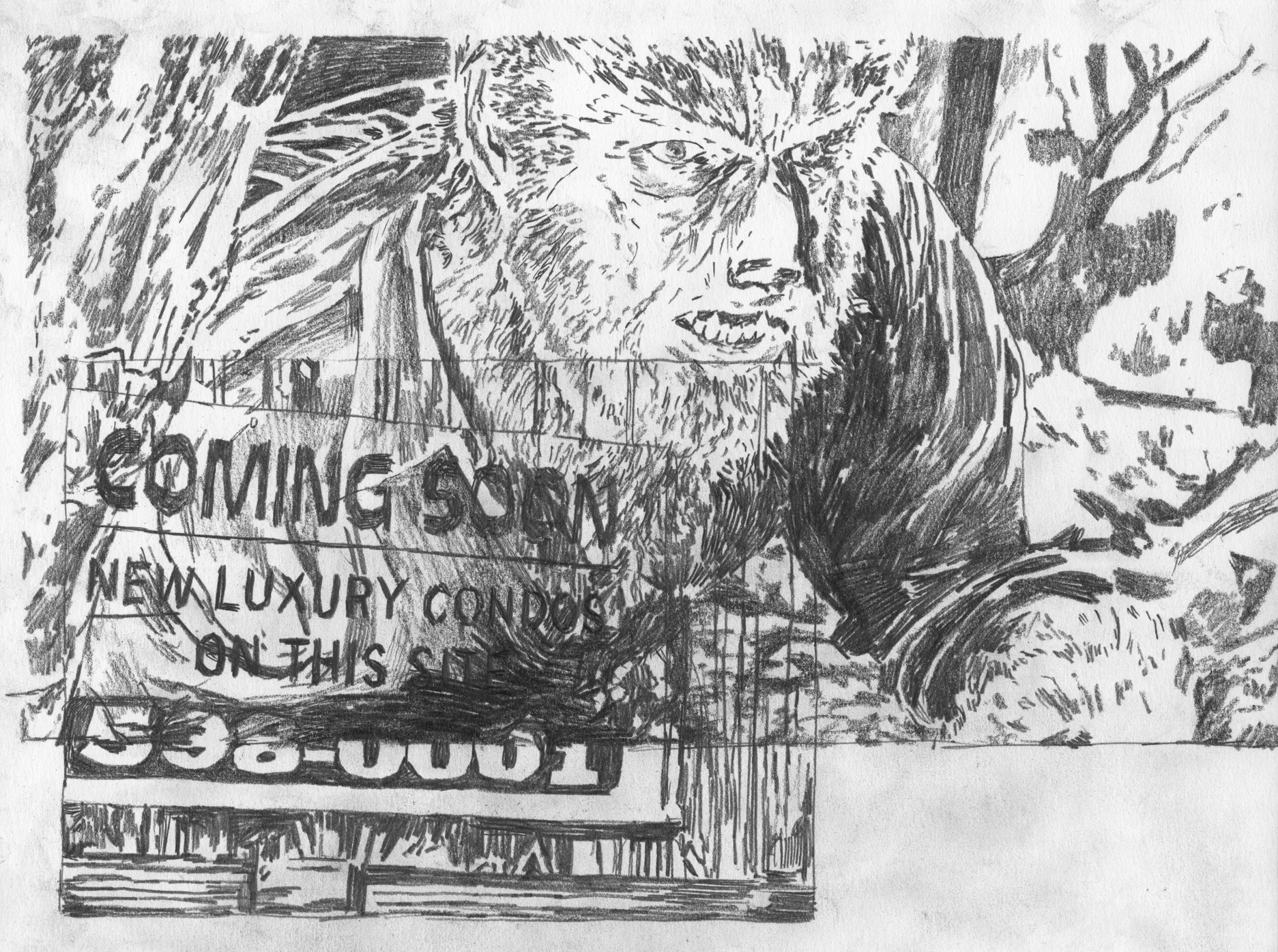“The city is a haunted thing” the Wolf-Man said. As he lay on the couch of Dr. Freud, his body tense with half-digested growling, emitting the stale smell of sweat, in the stuffy office of the psychoanalyst. The office of the doctor was a crowded assortment of plush Victorian furniture, artworks, a well-stocked library, myriad antiquities and collected bric-a-brac. Everywhere one turned there were heads, carved in stone and ivory, shaped in porcelain and marble. There were oriental rugs on the floor, but they were somehow out of place, and he had a distinct feeling that the whole room had somehow been turned around, mirrored, since his last visit. The Wolf-Man found himself wondering what could be hiding under the doctor’s desk. The whole place had the air of wunderkammer; a jules-vernian-livingroom-turned-timemachine. It seemed to him a submarine, a finite egg-like world traveling through a hostile environment. The room smelled of incense, cigar smoke and fear. A space where bourgeois man had become master of a domain that was not just the known universe, but also the unconscious one. The Wolf-man clamped onto the couch with fingers stiff from some memory of dreams full of trees full of wolves, like savage fruits. Multitudes of snarling and fangs and assholes. Intertwined in the foliage, with tails wagging, ears a-point, beasts of wastes and desolation. Conjoined and indecipherable from the branches, leaves and roots. A mycelium of wolves. The graveyard of your fucking species. He knew that Freud knew nothing about wolves, or anuses for that matter. And he knew that the doctor would soon prescribe him one medicine or another. “Would you like to be a wolf?” the doctor asks. He answered haughtily, “How stupid, you can’t be one wolf, you’re always eight or nine, six or seven”. He knew that in becoming wolves the important thing was the relation to the wolf-multiplicity: how the subject joins or does not join the pack, how far away it strays, how it does or does not hold to the multiplicity.
The wolf-multiplicity was not quite a crowd but a struggle for kinship, it was always at the periphery of the dominated territories, as if attached by limbs – a hand, a foot, a tail. Through its mouth, the name of the city. A flux of wolves, their movements unpredictable and following no rhythm. In the public eye, the headlines and minds of policymakers, The wolf-multiplicity was an abject body politic, a sick limb from which they could not detach themselves, a reminder of something indeterminable and unruly, something monstrous and hybrid. Contagious fringe inhabitants of The Contested Zone. In the public mind, such inhabitants had to be shielded off for the good of society, lest they contaminate the healthy-body-politic. A contagious swarm, moving about as some gluttonous hex, a yoke of matter, movements of fur and fang along the societal base. The Wolf-Man is adrift, somewhere close to dreams smelling like ink, like liquid buildings, like poisons and rare salts.
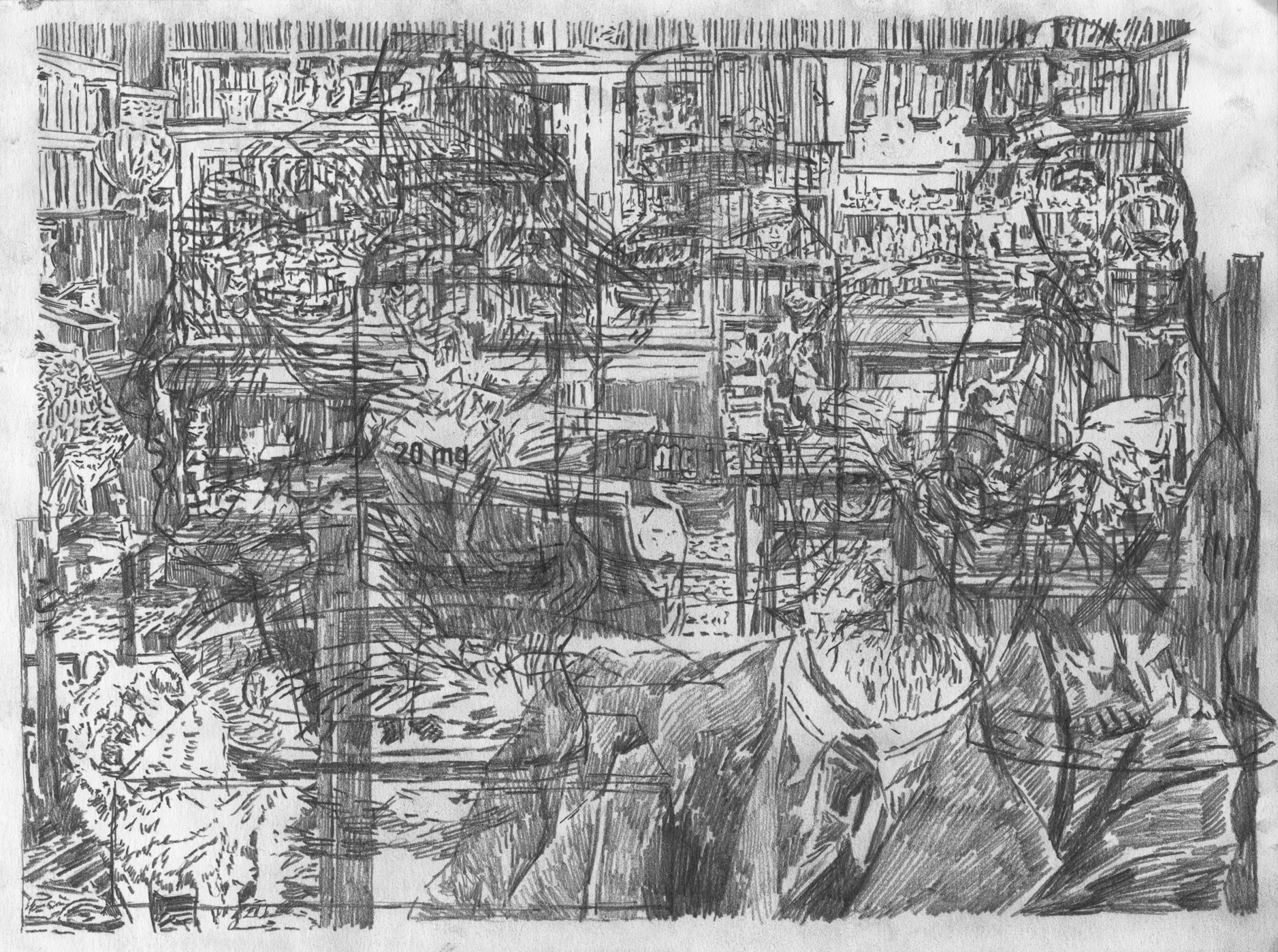
The healthy-body-politic was a paranoid bureaucratic machine, sweating brittle from nightmares of waking up transformed into a beetle, husk and all, crawling and hissing; being unable to go to work that day, or the next. It’s father chasing it under the bed for shame. The reoccurring nightmare was always anchored in the possible contagion (or catastrophe) of the multiplicity, be it wolf or beetle. In the domestic dreamscape, of the beetle and its shameful father, the horror for the healthy-body-politic consisted in a rift of relation and production of relations, between the father and the beetle. A gap in ontological production of man, or animal. The healthy-body-politic wakes up in tears, cursing the subconscious multiplicity.
Dr. Freud was polishing his glasses and prescribing antidepressants.
Wolf-Man, Wolf-multiplicity, man-wolf, wolf-individual. Stalking out of the forests of some other century, some fringe-becoming-form, surrounded by hatred and envy and hatred.
There are several problems with policing the unconscious.
“The process of psychoanalysis,” Dr. Freud said, “is retarded by the dread felt by the average observer of seeing himself in his own mirror.”. The Wolf-Man suspected that he was a mirror of sorts, some kind of opaque surface through which someone, somewhere else, was observing not himself, but the objects and buildings surrounding him. Leaving the doctor’s office at Berggasse 19, to return to his home in the apartment blocks, in The Contested Zone, the Wolf-Man felt as much, if not more distress than he had when he went to the doctor. Claws of the financial high noon scraping across his tendons. Shimmers, shimmers, and shivers. Walking through the inner city, along the avenues lined with bustling cafes and gleaming storefronts, he felt a deep sense of dislocation. He felt like he was in the wrong place, or not able to occupy a space altogether. It was an uncanny sensation of being at odds with the architectonic angels of the setting around him, like the geometries of the space was all right, but he was all wrong in them. In the surface of the window of a Bank of Austria brach, he stared at his own reflection, seeing himself exteriorized, all jaws and snout and yellowing eyes in the wrong place, and what was starring back at him was not a reflection of Wolf-Man, or Wolf-multiplicity, not even how others might see him, a wolf-individual, but rather the reflection of himself occupying a space where he was not. A fundamental architectonic displacement of his body into a zone of not-belonging, a territory of bodily estrangement. “Around here I am more prey than predator,” he thought.
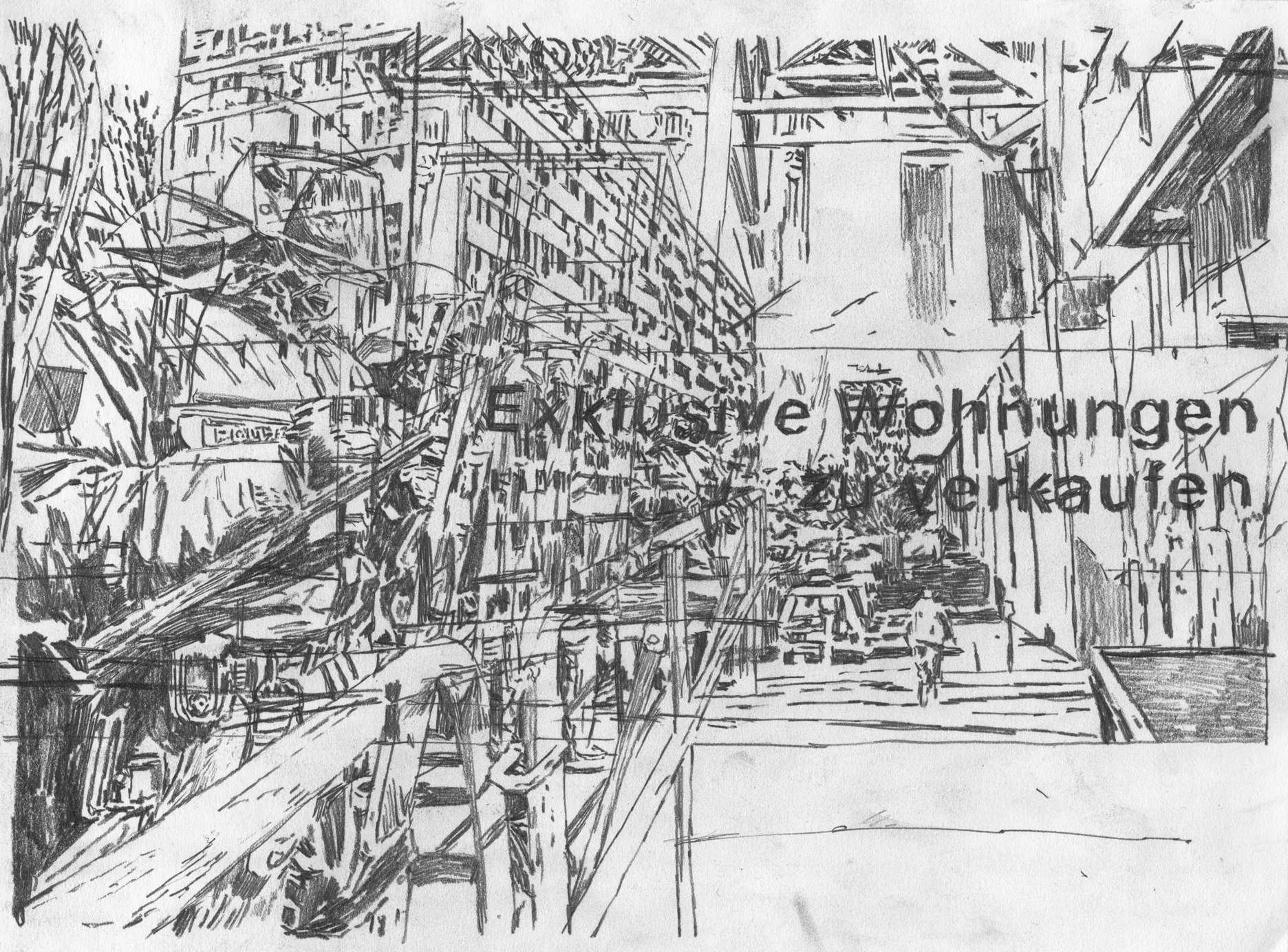
Once outside Dr. Freud’s office, he felt the city gaining on him, like a pack of dogs, a’drool and tongues licking at it’s own necrotic breath. Paranoid old ghosts of empire were being supplanted by new ones. The fortifications of Ringstrasse had been torn down, and replaced by a wider boulevard, and then there was the business with all the borders, they were becoming a right nuisance for getting around the City Proper. Things were being torn down and rebuilt left and right. Everywhere space seemed to be opening up in the fabric of the city, to become liquid and possible, only to coagulate into yet another financial construction propagating speculation, leisure and consumption. The Wolf-Man jangled the few infernal coins in his pocket, as he quickly paced down the too-wide boulevard. The whole thing had an air of HausMannic militarization about it, a deliverance of urban space into police infrastructure to defend the bourgeoisie against an internal enemy, an exo-intestinal fright. Along with the borders and police stations placed strategically around the poorer neighbourhoods, the nexus of council and planners had created a more invisible yet equally militarized infrastructure, in the form of the Boulevards, too wide for the construction of barricades, open to commerce, and fields of vision, for tourists and planners, bankers and cops. A stereoscopic rendering of the city in birds eye view, criss-crossed by open asphalt planes, anchored in monuments. A landscape hard for the rabble of wolves to hide in. Hausmann might have said; “I propose to you, that all real-estate is about politics (or vice versa). Or he might have said “One might view civilization as a process of fortifying against wolves”. In a fit of capitalist realism, or policy proposal; a teleological rereading of civilisation as lupicide.
Proto-capitalism was always a colonial business, Haussmann, a known lupophobe, knew this very well, and dispersed himself as a signal, as empire. The creation of the in-and-external Other was carried out by language, image and torture. The destruction of the Commons, by hedgerow, violence and prosecution. The whole business of fences and hedgerows were always assertions of human supremacy (above wolves, beetles & myceliums of any sort), disavowal of human-animality and attempts to erase configurations outside of the reach of policy makers and planners. The invention of private land ownership, came to spark a hundred years of “hedge-riots” as well as five hundred new laws targeting gleaners, vagrants, peasants and the working poor. Otherfication was always at the base of the construction of The Market, as were the drawing of maps (hic sunt dracones). In the office of Dr. Freud hangs such a map of Vienna, or maybe Paris, or London? All metropolitan space seemed to superimpose itself on one another, to merge as by some hereto unknown urban-quantum law. The map showed the City Proper, on its flank a large collection of grid-structured housing projects were encircled by a barrier of multilane freeways, detaching them from the vital functions of the urban body-economic. Like an unwanted extra arm. This is the Contested Zone in which the Wolf-Man lives.
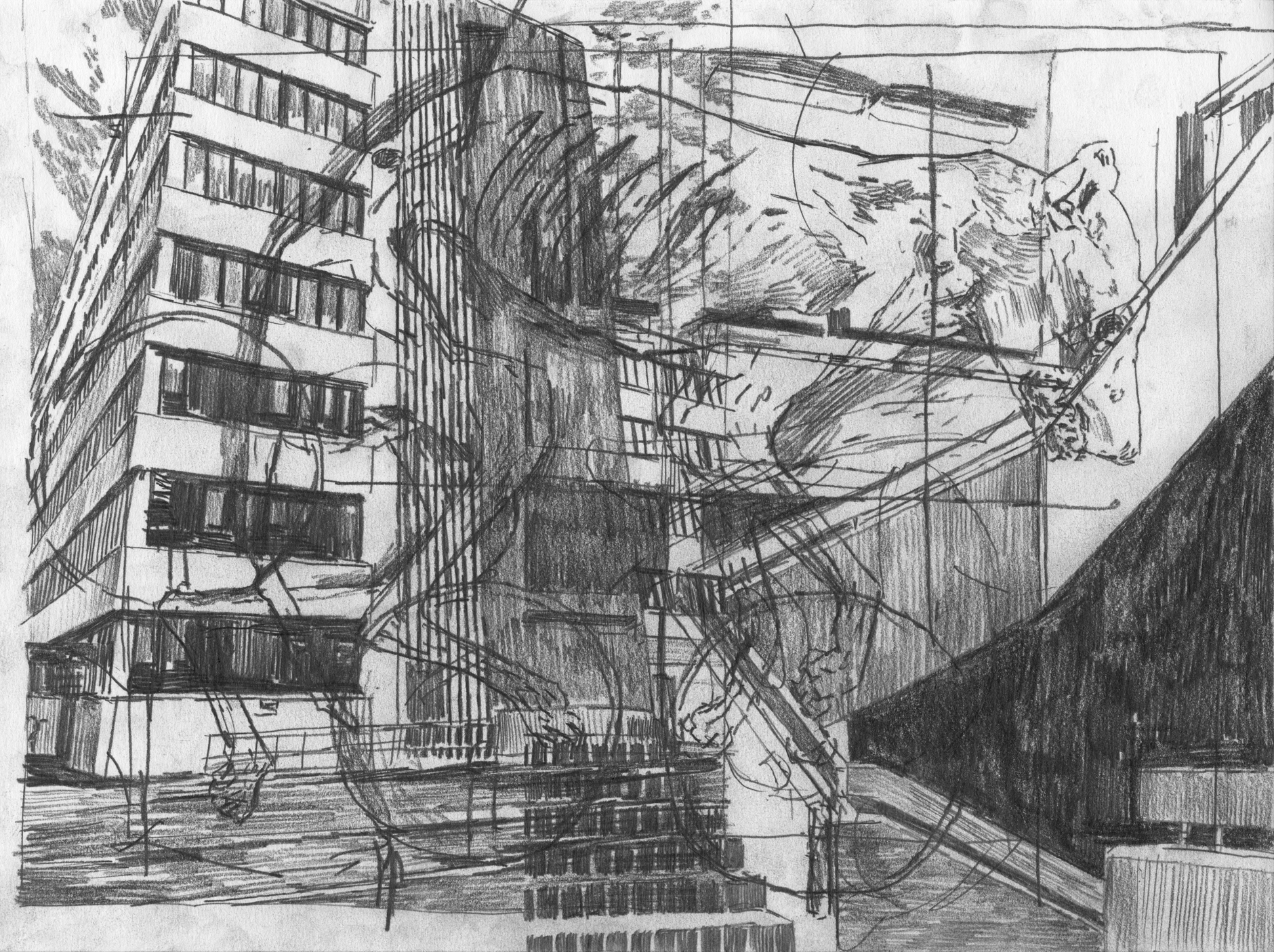
Some time ago, the council had engaged in a strategy of urban development consisting entirely of borders, big and small. Some were merely marks of separation – traces drawn on the ground, some were shaped like houses, car-parks and things not easily recognised as borders. Some were entirely invisible perimeters, some made up of language and geometries of culture & capital. Others were raised as a concrete barrier, an actual wall, with barbed wire and fortified viewpoints. All the separations, in addition to affecting the physical space of the City Proper, also became ethical and political constructions; announcing divisions between what was permitted and what was not, what was legal and illegal, between included and excluded. The borders were also an aesthetic machine. Implicit in each were colonial imagery of keeping at bay the savagery and underdevelopment beyond. Out there in The Contested Zone, were collected what was generally view as an agglomeration of insecure urban spaces, inhabited by the wolf-multiplicity, of dubious morality, a disorderly criminal throng, recognised by class, or ethnic identity markers. The borders said: “The city would have to be colonised anew to become habitable, again”. They said: “The Contested Zone had to be rationalised and conquered lest it should fall to the Commons”. End of the world by wolves.
The wolf-man can’t pay his rising rent. Much less the bill of the expensive psychoanalyst, or the drugs he prescribed. He lives in a twelve floor apartment block, somewhere on the wrong side of the Ringstrasse. His stairwell smells like piss in the morning, blinking schidzoid neon of welcome. Each day he is greeted by teeth of the freeway, by cops in armoured cars, by smog, by slow-burning malaise and civic melancholy, but also by fully theatrical, spectacular catastrophes. Our epoch’s accumulated urban nightmares: thousands of buildings, endless tedium & desolation, gangs, drugs, arson, murder, terror, poverty and parking lots. Garbage-strewn wilderness, and beyond that benign neglect and planned shrinkage. “Out here there is no real distinction between decay and ‘renewal’, they are both different modes of urbicide,” the Wolf-Man thought. On the horizon along the concrete pylons of the Ringstrasse – The emergence of a feral neoliberalism against a backdrop of urban dereliction and real estate speculation. All territory was subsumed by the metropolis. Desolation was being pounced upon by real estate opportunity. Zones of placeless mourning and laments of the steady cancelation of histories, only interrupted by seasonal riots and the decomposing bodies of activists being dragged from the Donaukanal, while a new commodity complex was conjured from an urban plan of ‘benign’ territorial dominance. “The neoliberal city is a deathship” read the graffiti on the boulevard.
From the line at the job center, to the police kettle, the glass facades of flagship stores & the dead eyes of the bureaucratic soul, there was an essential violence being wrought as a process of urban transformation, driven by ruthless economic ambition and acceleration, sustained by parallel political forces rooted in ideological justifications of the social cleansing of the City Proper. Violence clad in the breeches of the gentry, in the fine taste of the bourgeoisie, in the consumption of space as commodity. A process of malign capital mutation of entire neighbourhoods at the service of dead labour. The housing question. The wolf-man passed beneath the pylons, junkies on the steps of the station stairwell, heroin days, speedballs and ghosts, so many ghosts that you could hardly move.
This was at the root of the Wolf-Man’s predicament, but none of the psychoanalysts understood this. Though the doctors generally agreed that the Wolf-Man was once a human, none of them could seem to agree on when he lost that specific quality. Most of them thought it had to do with a contagion of sorts, at some earlier stage in life, a personal transgression or perhaps some hereditary condition. Most of them agreed that you could medicate against it. The Wolf-Man thought it had to do with the City Proper. Not that he perceived the city itself as a malicious thing. It was not that which was the root of his “condition”, it was just that he felt that he had been misplaced, forcefully, and no longer had the capability to occupy or inhabit the space around him. He could no longer map, or smell, and in his case, the two were the same.
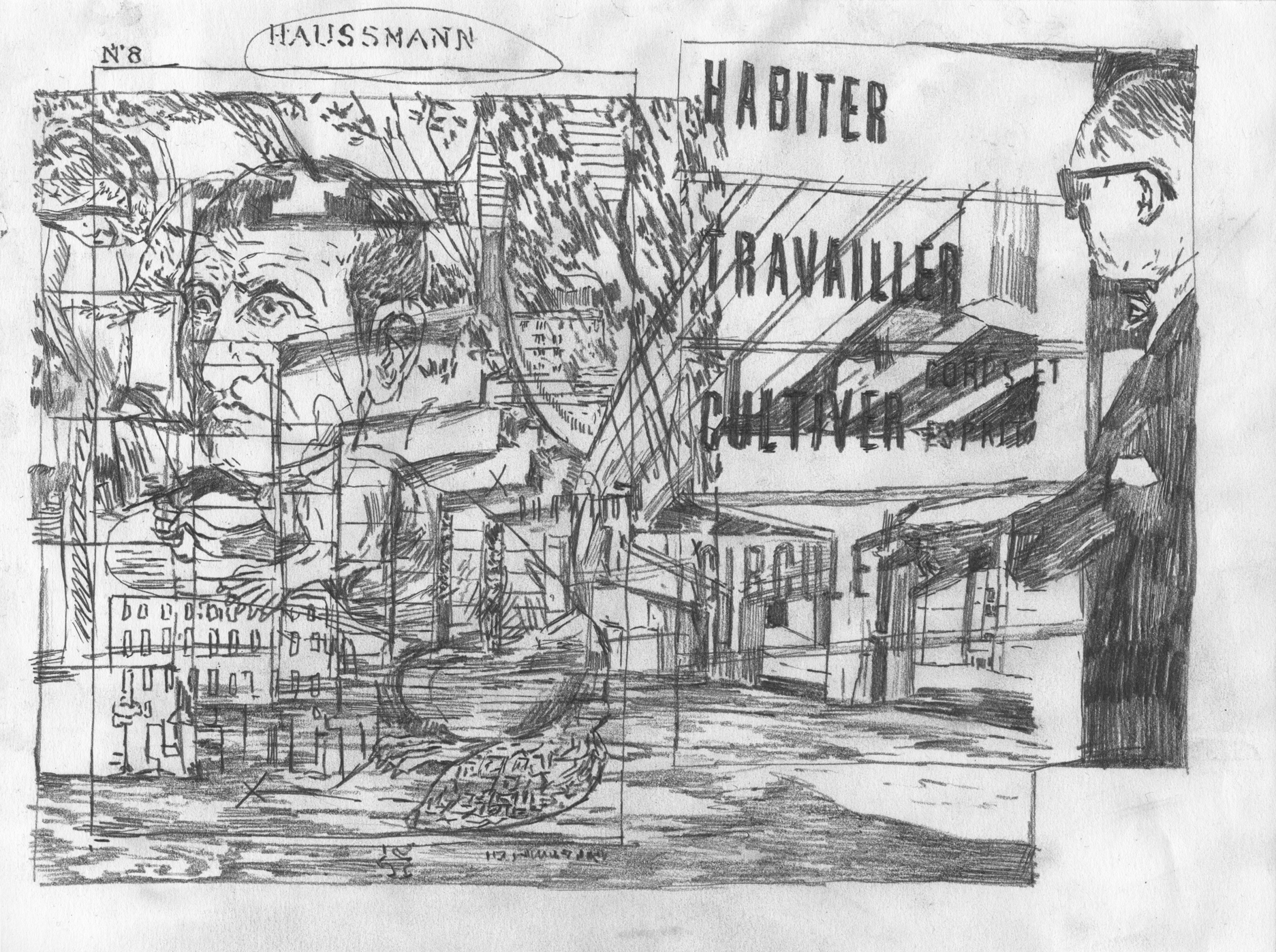
It had happened slowly at first. There were the stories and myths, wolves eating your relatives and dressing up in their blood-soaked garments (o’ why are your ears so long grandmother?). The air itself had changed and been fouled, by bigots and outright fascists. Then came the changes in policy, the laws targeting certain areas, certain parts of the population. And simultaneously, changes in the patters of consumption relative to housing, managed by the public authorities, for the common good. Then came the deserts of the middle-class, a reorganisation of the social mass they said. Strategies for rejuvenation and renewal. Then came the dispossessions. And at first he had thought that the suffocating feeling brought on by each morning had to do with the smog, or his precarious job, his low-income status. Maybe he was on the wrong diet? He lived in the City Proper back then, in a tiny apartment yes, in the smell of many different meals cooking and the maze of backyards and different tongues speaking a Neighbourhood, with histories. He had worn a different name back then, and had a more human form. Before the uprooting, the expulsions, the dispossessions. Now he lowers his furry head, passing under the concrete pylons marking the entrance to The Contested Zone. Plastic bags stuck like bleached tumbleweeds to their base. Cops circling by the wolf-Cubs standing on the corner. The pylons were one of the many border constructions that had infiltrated the city, and as with most of them, they had gained an aesthetic and ideological function. One could say that all the borders had the thing in common that they revealed as much as they disguised. Some of the more mythic constructions brandished names and faces of individual entrepreneurs, transforming the world from neighbourhood to neighbourhood, while profiting personally. The more invisible of the borders were the ones that hid things. Things at work on a much larger, more global level, of which the city was just one arena, one set of agencies, committed to a specific development, which was playing out at the heart of that specific urban space. These were the borders of class, of profit and surplus value. Strung out like ley-lines animated by deregulated economic activities, they hummed with sub-frequency siren wailings, restructuring capital flows, redirecting bodies and masses towards the zones of services, leisure and consumption.
There had been the forceful evictions, the systematic displacements, direct or by proxy. There had been the dictated withdrawal of essential services from neighbourhoods deemed undeserving of survival. There had been twenty years of activism, organising and initiating tenants associations and unions and rent strikes. There had been legal proceedings against property owners, there had been demonstrations, there had been more evictions, burnings, riots and lootings. There had been the long dread of estrangement, the racism and the smashing of storefronts and the culling of tongues. Reuse and usurpation of land and blocks, traitors in the unions, traitors on the streets. There had been an area of mourning and fever. Of shimmering moments of actual change and the devastating summers of hegemony. He used to be able to map different parts of the city in his head, but it had become incomprehensible to him these days. He thought that maybe it was his own position in the urban totality that had shifted, that he himself had become a terrain-vague. An unsite. Sure it was the way of things those days, the rising rent and the tide of money and capital-bodies. But it was also about the erosion & erasure of the geographies and histories of the poor and working classes of the city, and the forces substituting these with a new set of urban futures. A new set of fixtures in the filament of colonized space, inner and outer. A return to the City Proper. “But a return of what monied-bodies?” thought the Wolf-Man.
The city had consequently become a divided space, an agglomeration of enclaves and geographies of segregation. A space of in- and external boundaries and invisible quarantine zones, policed and surveiled by agencies and apparatuses of control. Public spaces, which hereto had been territories of collective self-definition, the result of encounters and contradictions, were transformed into zones of domestication. By violence and myth. The Wolf-Man knew the stories; for a wolf to return to being human and shed its wolf pelt, it must either be captured and combed, or have it’s right hind paw chopped off with galvanised steel, and it would henceforth live like a human with the marks of that arrangement. Transformation through domestication or mutilation. The Wolf-man very much wanted to avoid either one.
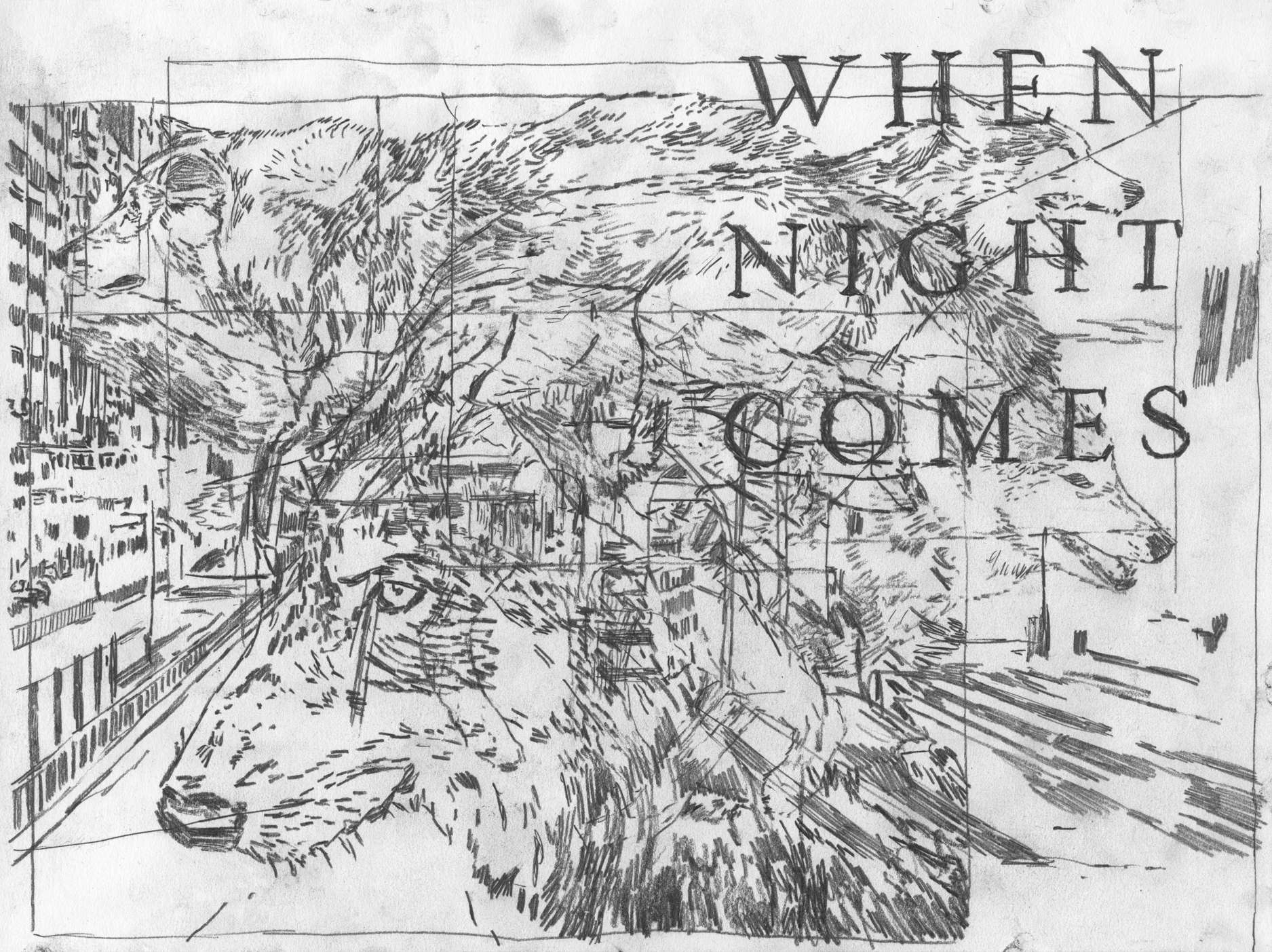
There was a dead dog floating outside his sixth-floor balcony window. It looked miserable and was becoming increasingly mummified in the wind. He assumed it had once been someone’s pet, and that it had somehow become cast out of the apartment block, like unwanted dead-weight on a space-capsule. Like someone had opened the scuttle and thrown the poor thing out. But somehow, unable to properly let go of its sense of belonging, to the community from which it was cast out, the dog was now forced to float there, at the will of the weather, like a strange satellite, hovering outside his window. He stared at it for some time while removing his jacket. The shape of the dog was dry and imploded, reduced to too little – a bagpipe without wind. In it’s single glass-like eye he thought he recognized something familiar, like some dream of a mirror, or the face of the doctor. He never much liked dogs. “We fucked them up”, he thought. Neurotic, stupid animals. He had to close the drapes, as the dog didn’t seem to be going anywhere.
Outside the night lit up in so many fires, once again. Cars being torched by cubs. Tearing through the sullen infrastructure, in shimmering howling forms. Chased by police with telescopic batons, armoured cars, teargas and guns, maiming and killing at will. The infrastructures were deaf-mute, things at the service of things, telescopic roads and armoured buildings at the violent hands of cops, at the service of Capital Order. There was a general disowning of the impractical burnings. A general notion that the infrastructural self-sacrifice of the disorderly wolf-cubs, the multiplicity of the young, was a symptom of the sickness of the city, lamentations of a generation of no futures. It was utilized by the policymakers to the ends of more apparatuses of control and surveillance. He thought that the burning cars had something more to do with a practical reconquest of a sense of place. The werewolf-face of the riots – the construction of an articulated ensemble, something which could be retained in memory. Something collective, where the individual wolf-subject could map and remap along moments of mobile, alternative trajectories.
The dead floating dog was whispering to him through the window, it’s voice uncannily like that of the doctor. “the city has secured itself as a space of normality” it said. “A fortification necessary for its function of absorbing the over-production and surplus-value of an economy, ruled by the exclusive logic of unlimited growth”. “Go away” he said, without getting up to open the drapes. “The patterns that consist the coexistence of the city are pushed away, marginalized, controlled, suffocated and destroyed” the dog continued. “Urban life dies and the city comes to exist in permanent crisis, in a state of exception ruled by regimes of security, whose goal it is to assure that nothing happens”. The sound of the sirens was picking up outside, as the police cars circled his building in a vortex of noise and blue flashing lights. “The city is for sale” the dog said, unaffected. He tried to remember the city, its streets and squares, something made not from buildings or the minds of planners, but from collective use, from festivals, from language. The gatherings, the habits and rituals had disappeared, into the monied machines of property speculation, and were now being sold as folklore. While the city had been divided into practical zones of production of wealth, consumption, habitation and decision. “A place of consumption, and the consumption of place” the dog whispered. The Wolf-Man was surprised that he could hear this, as the sirens were now so loud that they seemed to be coming from inside the apartment. His sparse furniture was being flooded with the blue light, seemingly coming from everywhere at once, out the pores of the very building. Fever, gas, putrid sound and panic, a cacophony of space tightening around his body, the apartment block an extension of some police-thing, some hostile gaze, a device for torture and then, a loud noise; like a stun grenade, shook the window, somewhere outside the cub-multiplicity was howling.
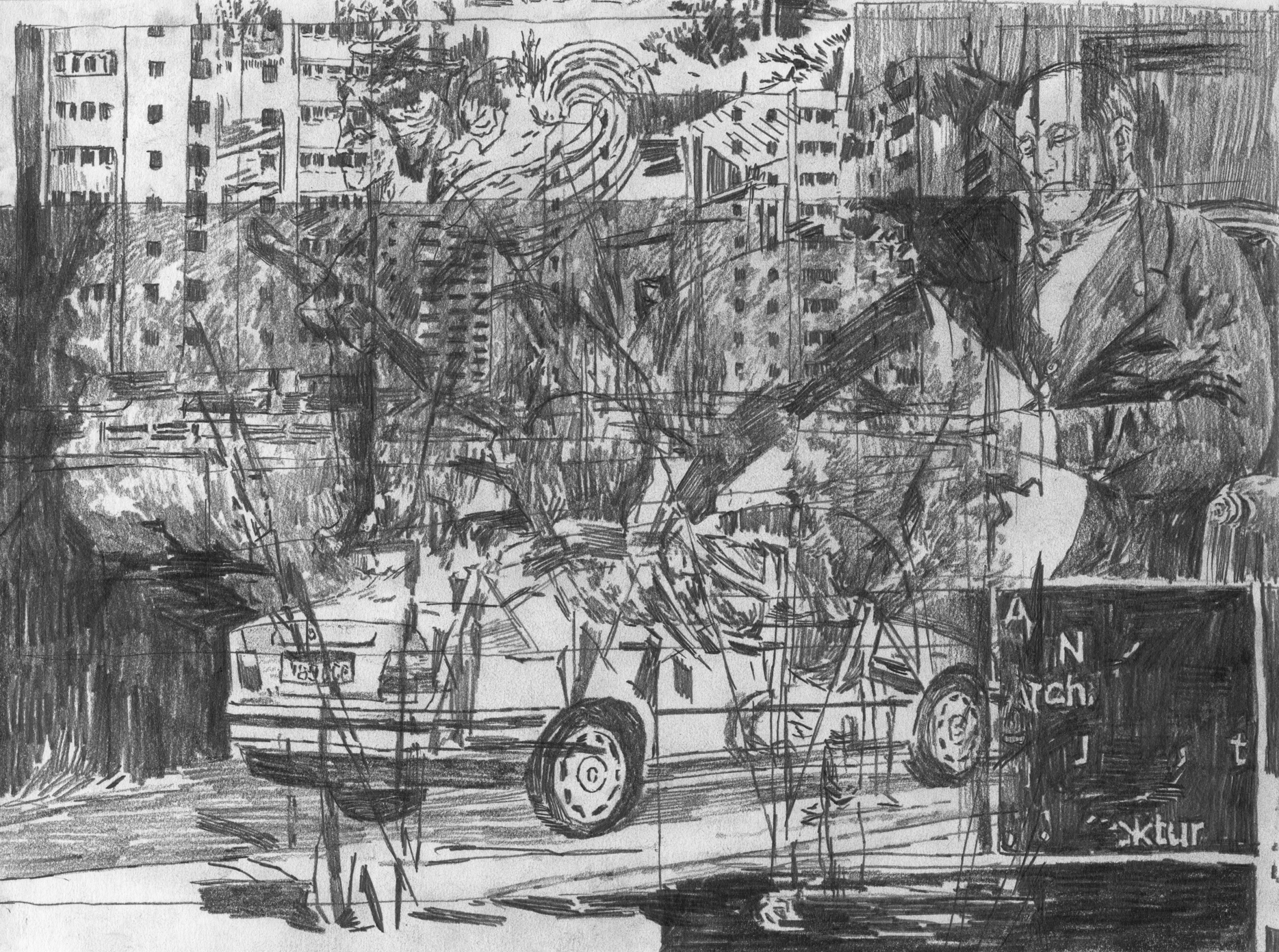
There will be bodies in the morning. Bodies in the smog, he thought. The night had fallen silent again. On the table, in their plastic container was the drugs that the doctor had prescribed him, still untouched. He was feeling more a sense of confounding loneliness than dread now. In the sudden silence of the parking-lots, the neon, the smell of piss in the stairwells, the low hum of the building, the mechanical hissings of elevators passing, he was overcome with a deep sense of isolation and grief. He found himself missing the sound of the stun-grenade, secretly waiting and wishing for another reverberation of teargas canisters going off in the street below, the sound of alarms and galvanised windshields of cars imploding in the fires. Something, anything. Tremors shaking along his dark furry form, a knot collected like glass in his chest, the absence of saliva from his tongue dry and dusty. He opened the drapes to stare at the dead dog again.
“I live here” he said to the levitating dog. “but do you?” it asked back, with what he thought was a smirk, if that mummified face of the unfixed carcass was capable of such a thing. The apartment-block hovered soundlessly like a space-capsule in the void of parking-lots of The Contested Zone. He looked at the shrivelled paws of the floating dog, then down towards his own. To inhabit is a way of being in the world, a way that was never, nor could it be individual. He thought of the City Proper, with is gleam and shine, its prosperous boulevards and electric skyscrapers. He thought of the apartment block, he thought of the borders, of the wolf-multiplicity, the flux of packs, of the loneliness of the car-parks, the surface of the pylons, the feel of fur under ones paws, the smell and sound of the stairwells talking in the many tongues of wolf. “To inhabit implies to create” the dog said, “to care for, and share spaces. In sharing we make ourselves and re-make ourselves in community with others.” The Wolf-Man looked past the floating dog, towards the satellite dishes lodged like so many eyes of the building across from his. Staring into the white electric noise of space. It was early morning, the hour of the wolf. Zero-hour in a sliver of colonial and geological time of the city. “Ever since Romulus and Remus were suckled by a shewolf before founding Rome, relations between your species have collapsed,” the dog said. He wasn’t really listening anymore. “Your neurosis is based on the fact that you are occupying the category of ontological impropriety,” Dr. Freud had said, on finishing yesterday’s session. He was beginning to doubt that it was him that was occupying that space, perhaps it was something else. He felt the knot of glass dissolving in his chest, into liquid and a low sound. Perhaps the city or the regime of dead things ruling it, was themselves ontological improper. As the night gave way to a new days smog, and the ghostly outline of the City Proper rose up behind the apartment blocks, as some ultimate dialectical barrier, or invisible limit, he was beginning to wonder who the real werewolf was, and of what it’s voracious hunger consisted. “Let the city eat itself”, he thought, and opened the window to let the dead floating dog in.
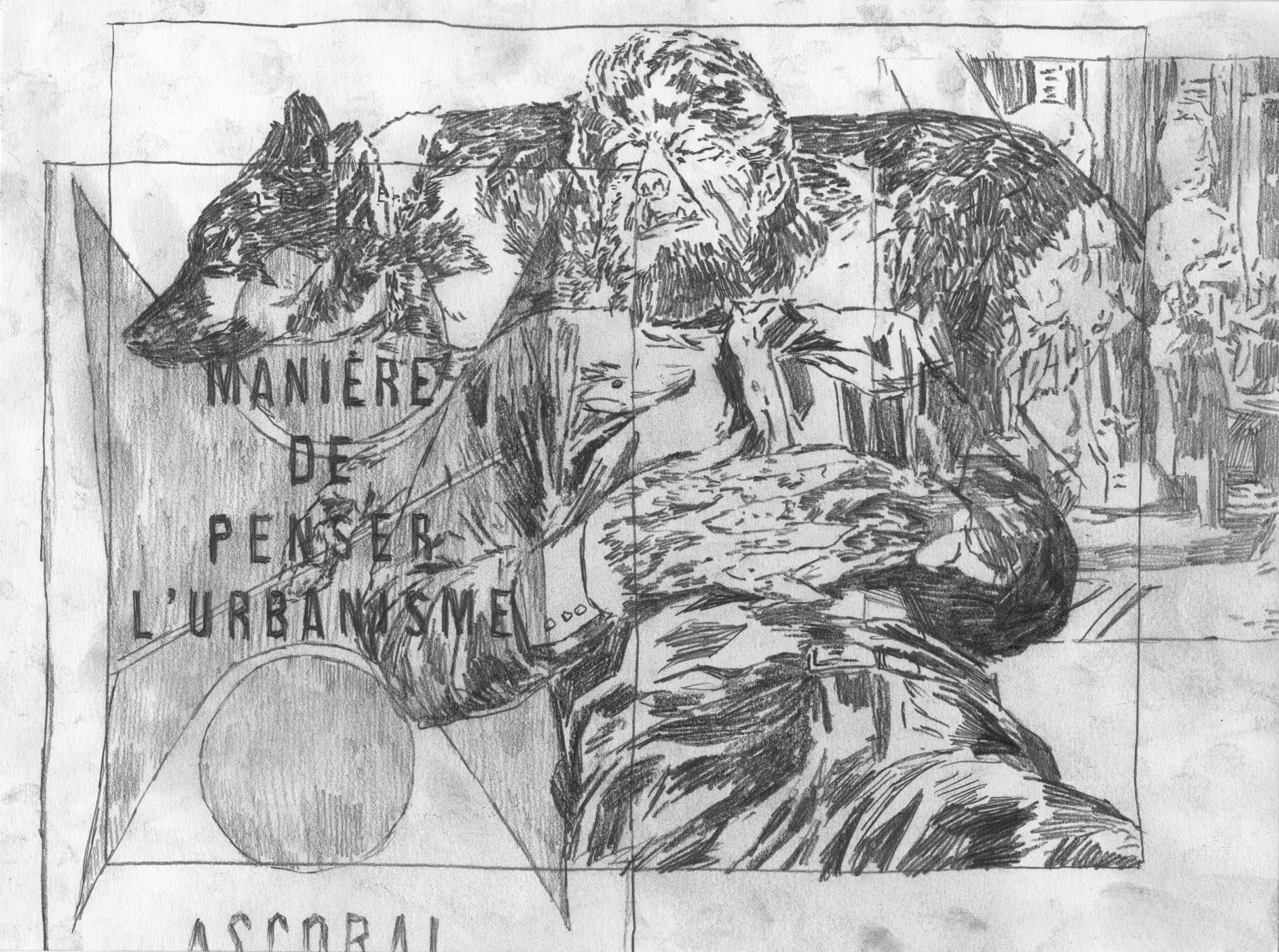
Asbjørn Skou is a visual artist from Copenhagen, Denmark. He works with drawings, text and objects, to stage and examine relations between human and nonhuman agencies, and their possibilities for pro-duction of crisis and critique. His praxis forms fictions on spaces of interaction, to speculate and narrate how humans, non-humans and hybrids are drawn into and dragged out of the neoliberal mesh. He holds a MFA from the Academy of Arts in Bremen, Germany. He has previously exhibited at among other; Overgaden Institute of Contemporary Art (DK), Kunsthal NORD (DK), Kunsthall Trondheim (NO), Tranen – Contemporary Art Centre (DK), Museum of Cycladic Art (GR) Vejle Art Museum (DK), Ileana Tounta Contemporary Art Centre (GR), Munch Gallery (USA) Contemporary Art Museum of Estonia (EST), Photographic Centre (DK) Rauma Art Museum (FL).


